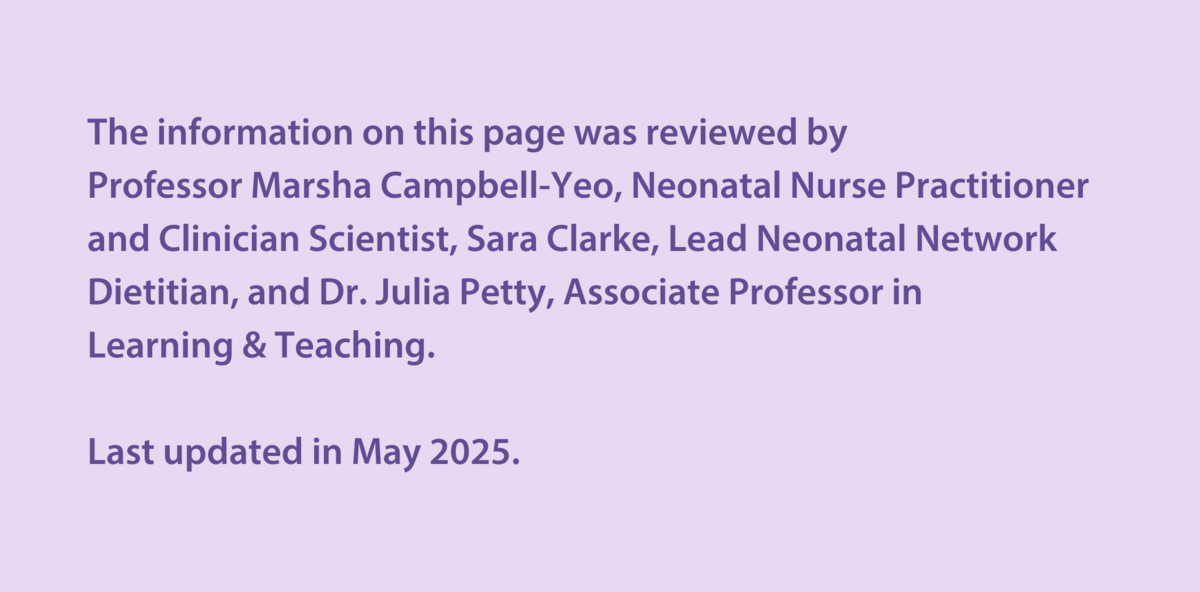Babies who are born at term but have health complications, such as surgery or difficulty swallowing, may also find it difficult to breastfeed. Similarly, babies with breathing or heart problems may have difficulty with feeding. Sometimes, they may need parenteral nutrition (PN) or tube feeding until they are ready to breastfeed or bottle-feed.
What is parenteral nutrition (PN)?
Parenteral nutrition (PN) is a liquid form of nutrition given directly into your baby’s bloodstream through a vein. This solution contains essential nutrients like vitamins, minerals, carbohydrates, proteins, and fats.
How does PN work?
PN provides vital nourishment to support your baby's growth. An infusion pump⍰ is used to deliver the nutrition gradually into your baby's bloodstream. In newborns, the vein in the umbilical cord⍰ is commonly used for this purpose in the first few days.
A doctor or advanced neonatal nurse practitioner⍰ will insert a tube (catheter) into your baby’s umbilical cord. The nutrition flows through this tube directly into the bloodstream. If PN is needed for an extended period, another tube (long line) may be inserted into one of your baby’s veins, typically in the arms or legs. Initially, PN may be your baby's primary source of nutrition.
Why does my baby need PN?
Preterm and sick babies may require PN because their immature digestive system needs time to develop further before they can tolerate regular milk feeds. PN ensures they receive essential nutrition to support growth while gradually transitioning to milk feeds.
Receiving PN is an important part of neonatal care and crucial for your baby’s growth and energy levels. While your baby receives PN, continuing to express milk can help prepare for when they are ready to transition to milk feeds.
When will my baby no longer need PN?
As your baby matures, tube feeding will be introduced to provide milk feeds (breast milk or formula⍰) directly into your baby’s stomach via a tube inserted through the nose or mouth. Milk feeds will gradually replace PN as tube feeding is established. The duration of PN usage varies, with some babies needing it for a few days, while others may require it longer.
What is tube feeding?
During tube feeding, mother’s own milk, donor human milk or formula⍰ is given through a tube inserted into your baby’s nose or mouth, leading to their stomach. There are two main types of tube feeding:
Why does my baby need tube feeding?
Tube feeding is often necessary for preterm and sick babies who may be too small or unwell to breastfeed or bottle-feed initially. These babies have low energy and nutrient stores, so it is vital for them to receive small, frequent feeds to provide nutrition for growth and development while they mature and grow strong enough to take milk feed themselves.
In preterm babies, the coordination needed for effective feeding – sucking, swallowing, and breathing – is usually not fully developed until around 32 to 34 weeks' gestation⍰. Babies born at term but sick may also take longer to coordinate feeding. Tube feeding ensures your baby receives adequate nutrition for growth and development.
Can I be involved in caring for my baby if they are being tube fed?
Yes, you can! Neonatal unit staff encourage parents to be as involved as possible in their baby's care. If you feel comfortable, they will show you how to give tube feeds. Staff will explain the process and show you how to:
Although it may seem daunting initially, with practice, you will become more confident. Administering milk slowly aids your baby's digestion.
If your baby is well enough to leave the incubator, you can also have skin-to-skin contact during tube feeding. This practice offers lots of benefits for both you and your baby, fostering closeness and boosting your confidence in caring for them.
When can my baby stop tube feeding?
Over time, you may notice feeding cues from your baby during tube feeds, such as mouth movements or sucking gestures. This indicates they may be ready to try breastfeeding or bottle feeding.
If you plan to breastfeed and your baby is well enough to leave the incubator⍰, offering them opportunities to be close to the breast during tube feeding may help them progress with their breastfeeding skills. As your baby becomes more interested and mature, they may start showing signs of taking milk orally. Gradually, as they improve at breastfeeding or bottle feeding, they will require fewer tube-fed top-ups, depending on their energy levels and feeding coordination.
Some parents worry about transitioning from tube feeding to breastfeeding due to the challenge of measuring milk intake. However, your baby will display signs of sufficient milk intake, such as feeding cues and wet nappies (diapers). The NICU care team will monitor your baby's feeding and manage any necessary top-ups. If you have concerns, discuss them with a staff member on your unit.
Learn more about how you can be part of your baby's feeding journey in the NICU.

